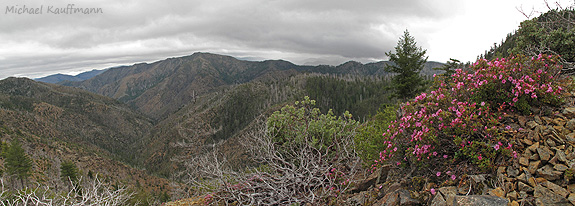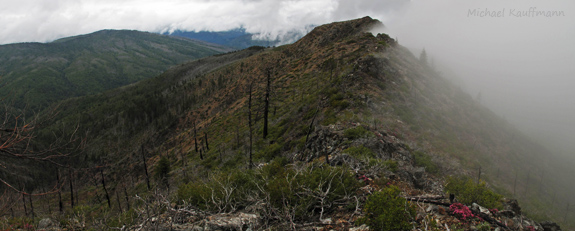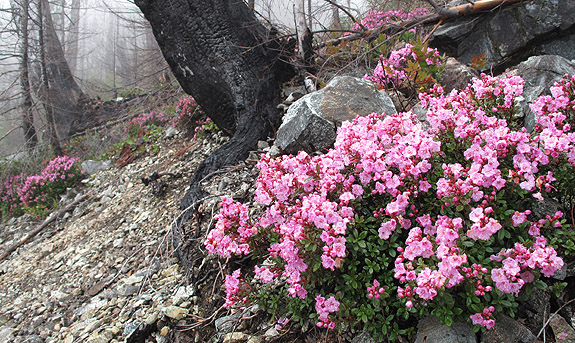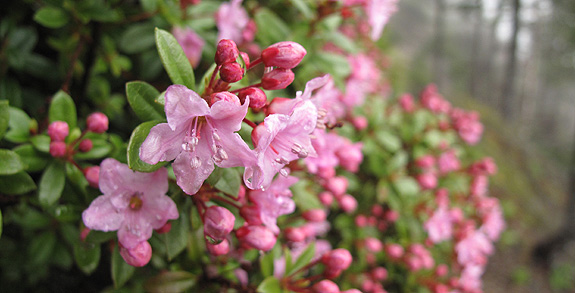Survival in a land of extremes
Original Publication DATE: 6/3/2010
With the end of the school year in site, my calcifuge tendencies had me running to the hills. Ever since our winter trip to Hawaii I have been pondering the Ericaceae family, gaining a new found love for this diverse group of plants. I also knew that they, like me, had a propensity to ‘flee from chalk’ so to speak. Ericaceous plants generally prefer, if not acidic soil, a harsh medium on which to grow. Could this familial disposition–to thrive in the presence of harsh soil–be due to the extant members of this tribe having evolved from a common ancestor? I thought I must visit one of the oldest members of the family and get to know where they grew and what they knew or could share. Though I have been hearing the call of the Kalmiopsis for many years, I had failed to yet make the trek into this remote country. With snow lingering this spring, keeping me from my typical high Siskiyou destinations, the time was right for Oregon’s second largest wilderness. The lower elevation wilderness is so named after a relict plant Lilla and John Leach discovered here in 1930.
Eighty years ago to the month these Oregon botanists were walking in the mountains west of Cave Junction when Lilla hesitated while gazing at a red patch of flowers, she got down on her knees and exclaimed “I have never seen anything like it before! Isn’t it beautiful? I believe it is new.” Her first impressions of the plant led her to conclude it might be a new form of black laurel (Kalmia polifolia). She combined that belief with the greek root “-opsis” meaning “seeing, like, sight, appearance” and coined a name that is forever in the heart and minds of plant lovers–Kalmiopsis. The two spent the following years searching for other locations throughout the rugged Siskiyou Mountains where the plant might be. Ultimately, a total of 20 individual locals have been identified–all of which are protected within the Kalmiopsis Wilderness.


Upon entering this realm, it seemed I had traveled back in time. When the tertiary forests dominated the northern landmasses of Earth–beginning around 60 million years ago–gymnosperms were in decline and angiosperms were evolving rapidly. Vast forests of magnolia, beech, chestnut, elm, alder, birch, aspen, sequoia, and ginkgo shared a common canopy. As the climate cooled these forests became restricted to regions where temperate conditions remained–places like the southern Appalachians, the mountains of eastern China, and the Klamath Mountains. Today, the Klamath Mountains still hold relicts from that time in the form of Brewer spruce, California pitcher plant, redwood, and one of the most restricted and rare plants in the world–Kalmiopsis leachiana. The species that were able to find these refugia, and find success over millennia of climatic changes, have an ancient stock of genetic codes–a library with a refined message.

The Kalmiopsis Wilderness is a crossroads. Rainy season storms can nourish the land with nearly 250cm of precipitation each year but this rain appears to have fallen in a virtual desert if one visits the in summer. Why is this? Because of the harsh soil derived from ancient ultramafic rocks–high in iron and magnesium. These ophiolites are known locally as serpentine outcrops and the heavy metals they contain are restrictive to plant growth. Where the rich soils of the coast foster the tallest trees in the world with 250 cm of rain, the harsh soils of the Klamath Mountains foster diminutive species with the same annual rainfall just inland and upslope. Serpentine is not only restrictive to plant growth it is also porous–so plants must be adept at water storage or retention to survive here. With heavy rain comes erosion and the Kalmiopsis Wilderness typifies the big shouldered canyons common throughout the Klamath Mountains, sculpted by downpours. Here, along Johnson Butte trail, the Chetco River is cut from serpentine origins and spills toward the ocean, thousands of feet below. Where I stand is the chosen outpost–over millions of years–for one of the oldest (if not the oldest) members of the Ericaceae family.
This landscape is not only sculpted by precipitation and geological character but by fire as well. The greatest fire in Oregon’s modern history swept through the southwest corner of the state in 2002. It was called the Biscuit Fire and burned nearly 500,000 acres across a landscape that receives significant rainfall but one also exposed to extreme summer heat. The porous nature of the soil compounds the drying and in the summer of 2002, after a dry winter, the forest was ripe for burn. The small amount of intact forest which survived the burn–whether it was luck or slope or a combination–is not composed of large and/or old tree specimens. This evidence suggests to me that frequent fire is a common and complex component of this ecosystem–and has been for several thousand years. This diversity is compounded by these harsh extremes–wet and dry, cold and hot, serpentines, fire or not. All of these conditions create a proliferations of microsite on which diversity thrives.
Conifer saplings are flourishing, shrubs are returning, and the Kalmiopsis leachiana–which many feared may disappear due to the fire–may be expanding its range. At a minimum it is burgeoning where there was burn. Diverse plant growth is re-establishing complex vegetation types that, to my amateur botanist eyes, were often so complex as to be confusing. In and around the Salamander Lake/Dry Butte area I saw associations I had never seen before. For instance, Brewer spruce (Picea breweriana) growing near Pacific madrone (Arbutus menziesii) and salal (Gaultheria shallon)–where coastal meets mountains. The most confounding message sent by this diversity is that it exists because of, rather than in spite of, the harsh conditions fostered here–intuitively it would seem that the extremes would inhibit diversity. However, this is the ancient meeting ground.

As the fog rolled in, I spent my last few moments in the wilderness with my new favorite relict — enough time for it to share itself and its landscape one last time before my return. I realized Kalmiopsis leachiana is a keystone member of this dynamically primal landscape and clearly of ancient stock. It has shared — over millions of years of deep time evolution–its primordial genetic code. My wife taught me that Kalmiopsis leachiana exhibits numerous characteristics that generalize the Ericaceae family. For example, the petals are fused, it has a woody stem, leaves are leathery, simple, and oval with entire margins, and they thrive on harsh soils. Kalmiopsis has surely shared these characteristics with other Ericaceous plants over time. We find many uses for it progeny, a heritage which includes food sources (think blueberry pie!) and delightful landscaping companions (think rhododendrons). Clearly, we are all quite familiar with this family. In that way Kalmiopsis leachiana — a purveyor and steward — is a part of us all.
Resources:
NPSO Article from 1991
Forest Service Wilderness Page
NPR Story on the wilderness area after the fire
COMMENT:
AUTHOR: Miguel Vieira
URL: https://www.miguelvieira.org/rememberedearth/
DATE: 6/5/2010 3:43:46 AM
Thanks for the great post on this rare plant and rarely-visited wilderness area.
—–
COMMENT:
AUTHOR: David Fix
DATE: 6/5/2010 2:30:33 PM
Thanks for recounting the history, Michael, as well as for the regional notes. My fondest Kalmiopsis memory is of “finding” a population of K. l. var.2 in Lane County while rating potential peregrine rocks for the North Umpqua R.D. It was a beautiful morning in 1991 and from just inside the Douglas Co. line up Dog Creek, or one of those tribs, I saw a rock farther n. which, with binoculars, had a distinct mauve-pink tinge riding a wrinkle of old geology. I had seen the plant distantly before, as on Limpy Rock, and knew what it was. I can’t remember the name of that rock but it was just across into Lane County. I suppose someone knows about this n. outlier.
David- I left this out of the discussion because there was little I could find on it other than it is called the ‘North Umpqua kalmiopsis’ and the ‘LePiniec form.’ There are some photos here . It seems it is even more rare but potentially easier to see if you know where to go. -Michael
—–
COMMENT:
AUTHOR: Jesse Miller
DATE: 7/3/2010 5:42:11 PM
Thanks Michael! Really interesting writing and great photos. I’ll have to go see it sometime.
—–
COMMENT:
AUTHOR: Rene Casteran
DATE: 8/3/2010 4:21:20 PM
Thanks for sharing. Very thorough and thoughtful with wonderful photo’s too. Kalmiopsis leachiana survival response to fire was also evident after the 1987 Silver Fire. When some populations were found to be dying, one theory for the cause was the absence of periodic fire due to fire suppression activities. Although I did notice populations slowly recovering before the Biscuit Fire. Also glad you got to experience that wonderful ridgetop extreme between the west and east side. I have seen sun and heat and fog and dew meeting on that ridge. Oh also about serpentine/peridotite, I believe it also has a high water table. Note the numerous small springs and the presence of Port-Orford Cedar. Thanks again for a great article!
—–
COMMENT:
AUTHOR: Gabe Howe
URL: https://siskiyoumountainclub.blogspot.com
DATE: 8/25/2010 6:10:24 AM
Nice work! Rene you are a legend!
—–
COMMENT:
AUTHOR: mephisto
DATE: 11/11/2010 8:25:49 PM
As a biologist/forester with more than 30 years professional experience, your field notes are fantastic both from the perspective of organization as well as the information provided! I hold a Master’s degree with a fire ecology specialization. Therefore, I especially enjoyed your discussion related to how Kalmiopsis leachiana is “flourishing” within the area affected by the Biscuit Fire. Smokey the Bear has “loved” our forests to death.
-
- Thanks so much for your feedback. -Michael
—–
COMMENT:
AUTHOR: Tanya Harvey
URL: https://westerncascades.com/
DATE: 2/5/2011 6:20:00 PM
Hi David,
I was very excited to come across your reference to Kalmiopsis fragrans (what used to be called the LePiniec form before it was officially described) in Lane County. No one in NPSO here in Lane County knows about any Kalmiopsis on this side of the Douglas County border. I am part of our Rare & Endangered Committee and would love to know where your Lane County site is. I’ve spent a lot of time in the Western Cascades along the county border and have never been able to find any Kalmiopsis north of Douglas County, most likely because it is limited by the geology. It always seems to be on those purple-tinged rocks like Limpy Rock.
Michael, Love your site!
—–
COMMENT:
AUTHOR: Taya MacLean
URL: https://www.npsoregon.org
DATE: 5/25/2011 7:59:39 PM
Greetings-
Tanya Harvey sent me a link to this article- wonderful! As editor for the NPSO Bulletin, I am always looking for potential articles and would love to run this piece with the photographs. Please let me know if you would be willing to submit this or other suitable pieces for publication in an upcoming Bulletin.
Thank you for keeping such an entertaining blog!
-Taya (bulletin@npsoregon.org)

Excellent, eloquent and lovely description of why, exactly, this area and these lifeforms are so special – very nice. Looking forward to seeing it and experiencing it.
JMB – Thanks for the kind words. I hope you get a chance soon to explore the Kalmiopsis! -Michael
Your kalmiopsis photos confuse me. The top two and bottom one look like what I know a Kalmiopsis Leachiana. The third photo is what I call a deeply colored form of Western azalea (Rhododendron occidentale). I wish it were a Kalmiopsis. I spent the day on the eastern edge of the Kalmipopsis seeking a Kalmiopsis and saw none. Heartbroken. This is my favorite shrub, and i long to see it in the wild. I saw several of these pink, fragrant azaleas though, so yummy smelling!
Hi Susan- thanks for the comment and for reading the blog. Those are definitely all Kalmiopsis pictures. The one you are confused by is a close up, but the flowers are still quite small. Azaleas are much larger. Good luck on your plant explorations!
Every time time I read about your adventures, I feel like I am there myself. Well written and fantastic photos! The kalmiopsis appears to be yet another fire dependent species.
Your comment concerning the unusual plant associations involving brewer spruce reminds me of the Kerby Peak trail. I noticed brewer spruce, pacific madrone and live oak and sugar pine. They are located at a fairly low elevation along the first mile or so.